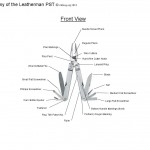For the first 38 years of my life, I coveted a genuine Leatherman multitool. Like many, I thought of Leatherman as a genre of tool rather than a manufacturer, and although I eventually came to realise that not all plier based tools were Leatherman tools, I was equally aware that I couldn’t afford one.
So, when my partner bought me a Leatherman Crunch for my 38th birthday, I recall being simultaneously delighted, yet slightly disappointed as I handled a proper Leatherman for the first time. Here was a fantastic tool, perhaps one of the cleverest multitools ever designed, but it didn’t fit the image I had in my mind of how a Leatherman should be.
I quickly realised that what I really wanted was a PST, picked one up from ebay, and I was hooked! The following is a detailed look at the history of the original Leatherman Tool, the PST, that has become an obsession of mine during the last four years.
As the months went by and my collection of other Leatherman tools began to grow, I started to realise that not all PSTs were the same but it wasn’t until I discovered a bunch of like minded souls at www.multitool.org however, that I started to realise I didn’t know the half of it.
Acknowledgements
Much of the following information and supposition is drawn from the incredible Leatherman PST Chronology Project thread from the forums at multitool.org, which is a fascinating journey of discovery, set backs and even contribution from Tim Leatherman himself. This, topped up by my own musings and experiences results in my attempt at presenting the History of the Leatherman Pocket Survival Tool, the PST.
Background
Between it’s introduction in 1983 and its eventual retirement in 2004, Leatherman Tool Group (LTG) sold something in the region of 10,000,000 PSTs, and the story of it’s evolution from the first production models to the honed, refined tool that was discontinued at the end, is as chaotic as it is fascinating.
The PST was eventually brought to market by the newly incorporated Leatherman Tool Group in 1983, and after a sluggish start became a roaring success. LTG tell the inspiring story of Tim Leatherman’s invention on their website, which makes for a good read.
In order to supply the ever increasing demand, production of the PST was partly outsourced for a while, with component parts being made by Japanese company Mitsuboshi Cutlery and LTGs base in Portland, Oregon USA. There is evidence that parts made in each location were shipped backwards and forwards, with assembly taking place in either location for several years. This makes it very difficult to pinpoint the precise age of a PST from the 1980s, but there are some things you can look out for during this period to narrow it down. From 1992, LTG started stamping the inside of PST handles with date codes (a practice that continues today with newer Leatherman designs) and things become easier. Other events, like the Californian court action against LTG for marketing their tools as “Made in USA” also affected the appearance of the tools, as “USA” markings were removed from blade tangs and plier heads.
All of this in addition to the natural “improvement driven” design changes to the PST make the business of tracing its evolution a formidable challenge, but with huge thanks to the guys at multitool.org, here’s my attempt.
The Anatomy of the PST
As there were no date codes stamped on tools until 1992, other characteristics of the PST must be used to approximate the age of tools prior to this date, so it’s worth understanding a bit about the parts that make up the PST, as they will be referred to in this article.
The diagram opposite shows the key components of the Leatherman PST, many of which can be used to approximate the period during which the tool was manufactured. For example, some features such as the Hard Wire Cutter Notch and the lanyard Ring were not present in early models, which helps us to narrow down when the tool was built. Some examples showing how features vary from tool to tool can be seen in this spreadsheet which catalogues my own, current collection.
Pages: 1 2

